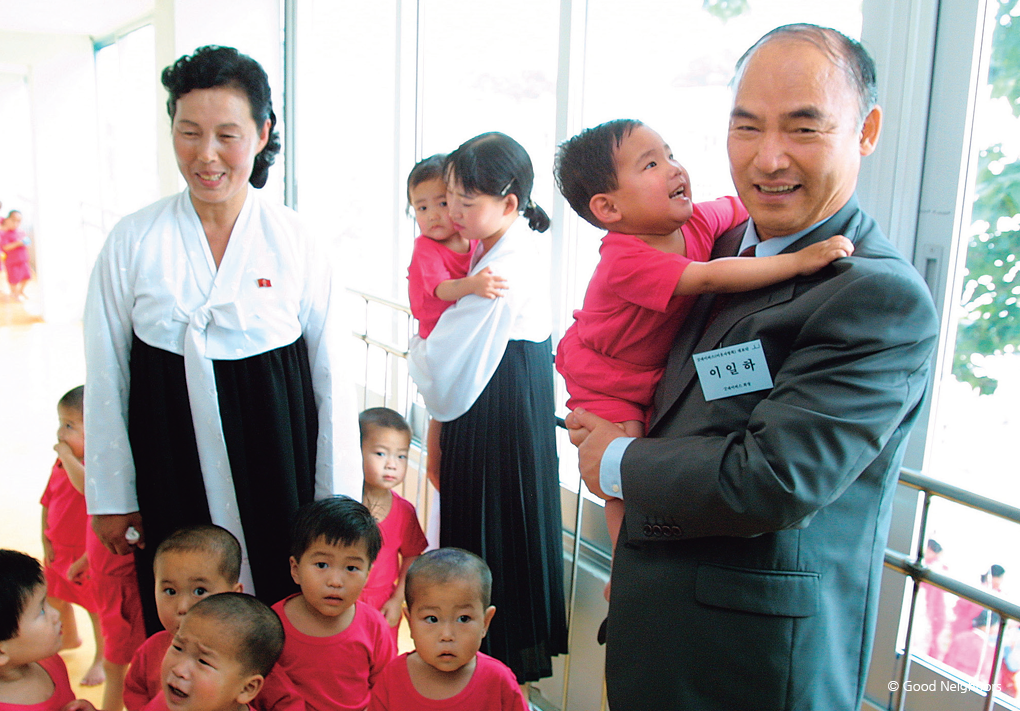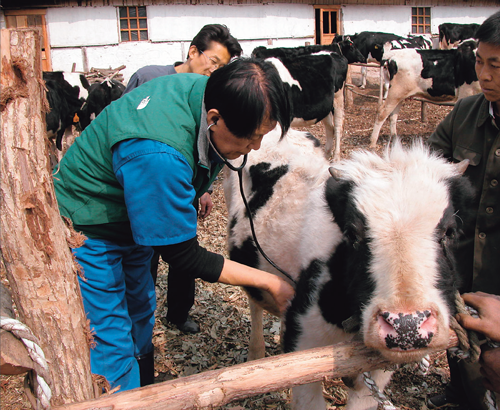Good Neighbors, an international NGO founded and led by Yi Il-ha, has been in the vanguard of humanitarian assistance in North Korea since the mid-1990s. The efforts go far beyond simple handouts, setting examples for the organization’s similar projects around the world.

Yi Il-ha, the founder of Good Neighbors, an NGO for international relief and development aid, visits an orphanage in Nampo, about 55km from Pyongyang, in 2004. Good Neighbors’ humanitarian assistance to North Korea since 1995 has included child protection, agro-livestock development, and health and medical services.
One of the most contentious issues surrounding South Korea’s approach to North Korea is humanitarian aid. Some regard assistance as a misguided and unfruitful effort spoiling the leaders in Pyongyang. Others urge charity regardless of the adversarial relationship between the two sides. Yi Il-ha, known as the godfather of Korea’s non-government organization movement, is in the latter camp.
The aim of Good Neighbors is a world in which hunger is absent and peaceful harmony is universal. Established by Yi in 1991, the NGO has 52 branches in South Korea and 303 offices in nearly 40 other countries. In 1996, Good Neighbors became the first Korean NGO to receive “general consultative” status from the UN Economic and Social Council (ECOSOC), the highest recognition the United Nations grant to NGOs.
A Hunger-Free World
More than 3,000 staff members operate the organization’s welfare and relief programs and there are more than half a million donors in South Korea alone. Early this year, Yi anticipated the end of a long freeze on civilian aid programs for North Korea. But the collapse of the second U.S.-North Korea summit in February in Hanoi dashed his hopes.
Yi had planned to build a large dairy farm and milk processing plant in North Korea, if Washington-Pyongyang relations improved. He intended to lay the groundwork for raising pigs, cattle and chickens, and build dairy processing and sausage factories. He had also hoped to supply South Koreans with samgyetang, or ginseng chicken soup, made in the North. He further had plans to help upgrade the North’s healthcare infrastructure. They included construction of a pharmaceutical research center, pharmaceutical plants and hospitals and other healthcare facilities, as well as factories to produce injectable solutions and capsules and herbal medicines. With U.S.-North Korea nuclear negotiations in limbo, however, all these plans remain on the drawing board.

South Korean veterinarians inspect milk from dairy cows at the Kubin-ri Cooperative Farm in Kangdong County near Pyongyang. Good Neighbors provided the cows and dispatches veterinarians and other experts to take care of the herd.
Dairy Cattle Project
Good Neighbors’ humanitarian aid programs in the North can be divided into three categories: child care and protection; agricultural and stockbreeding development; and healthcare services. The NGO’s presence in the North began in 1995, when it started delivering food and daily necessities. At the time, North Korea’s economy was on a downward spiral, which culminated in widespread famine in 1997, the year Yi visited the North for the first time.
The next year, Good Neighbors’ paradigm changed when Chung Ju-yung, founder of the Hyundai Group, delivered 1,001 heads of cattle to the North in two spectacular parades of 50 trucks across the Military Demarcation Line. Following Chung’s example, Good Neighbors delivered 200 pregnant dairy cows a few months later and built dairy farms in the North. Chung’s largesse was publicized, but North Korean officials wanted the NGO’s deliveries to be unreported.
Yi agreed with no objections. However, the fact that the cows were kept in quarantine in Incheon before their delivery became an open secret and they were filmed by a TV news crew as they left the port, upsetting North Korean authorities. After twists and turns, a total of 510 dairy cows were sent to the North and became the herds of four new dairy farms.
In fact, the idea of sending dairy cows to the North was conceived in 1995, when Yi visited the Chinese border city of Dandong. There, he met an Australian of Korean descent who had sent 200 head of hanu, or Korea’s indigenous cattle, to the North Korean city of Haeju, only to be told that dairy cows would be more helpful.
Convinced that the North Koreans could have a future if they had a viable dairy industry, Yi consulted a senior dairy industry researcher in the United States. He promised to help but ran into U.S. government disapproval. When a fellow Good Neighbors member working for Seoul Milk learned about the logjam, he helped Yi buy his company’s 200 pregnant dairy cows at a giveaway price of 1.5 million won per head.
A secondary reason for Good Neighbors’ interest in starting dairy farming in the North was that herds would require ongoing exchanges between North Koreans and South Korean veterinarians, dairy experts and Good Neighbors staff. Sure enough, Yi and his staff have so far made some 140 visits to the North — Yi about 120 visits himself.
Eventually, North Korean officials wanted milk processing equipment to increase the added value of milk. After building a cheese processing plant for them, Good Neighbors attached one condition: half of the profit had to go to villagers and the other half to feed destitute children.
Raising Incomes
The success of this project exceeded expectations. The income of residents in Kubin-ri, a rural village in Kangdong County on the outskirts of Pyongyang, jumped 10-fold in five years. Naturally, the village population grew as well. The villagers were so proud that they described their achievement on a placard, writing in large letters, and placed it at the entrance to their village.
After seeing the success of the dairy project, the North’s Agriculture Ministry asked for support for chicken farming. It raised the need to buy expensive eggs to improve breeds, as well as equipment, from overseas. Good Neighbors purchased eggs of the most productive egg-laying chicken breeds from France that cost 5,000 to 200,000 won each, while the North built a chicken breeding farm that was off-limits to outsiders within the radius of 4 kilometers.
Again, success bred a request. This time, it was a fertilizer plant. Good Neighbors planned to expand an existing zinc factory near Wonsan and sell zinc produced there to supply raw materials for fertilizer. The project started with a US$1.5 million grant from the South Korean government and a US$7 million bank loan. It was so successful that the loan was repaid in just two years.
All in all, Good Neighbors has helped some 220,000 North Koreans, including children, at 25 worksites throughout the North. The NGO’s experience in the North has become a reservoir of models to conduct regional development projects in other parts of the world.
Good Neighbors’ food delivery programs for daycare centers in various regions help address chronic food shortages in North Korea. In 2018 alone, 114 tons of powdered milk was sent through Good Neighbors USA. Other deliveries aimed at children have included 150 tons of paper for printing textbooks and educational computers, as well as inline skates and soccer balls.
“Before anything else, we should develop specialized relief programs for them. We need to strengthen the human and material resources of the North’s agriculture, stockbreeding, healthcare and education.”

Chongsong Pharmaceutical Company in Pyongyang produces dosages for injection. Good Neighbors is helping North Korea improve its health care system.
Food Assistance
On a bigger scale, Yi believes, the humanitarian food assistance program that is currently in public debate in South Korea should have been implemented earlier. “It’s a little late to do it,” he says.
“But the North isn’t in dire need of a few hundreds of thousands of dollars from the outside right now. Before anything else, we should develop specialized relief programs for them. We need to strengthen the human and material resources of the North’s agriculture, stockbreeding, healthcare and education. The North is also interested in sustainable development cooperation rather than food or fertilizer aid.”
Yi recalls an unforgettable experience at the Kubin-ri Cooperative Farm. He and a few members of his staff stayed there for about 10 days and became very close to the locals. Together, they caught fish in a stream and then prepared and shared a spicy fish stew.
“You can achieve success if you invest in the North, regarding it as a potential market with outstanding talents and abundant natural resources,” Yi says. “We can achieve unification early if many more North Koreans have chances to work and share experiences with South Koreans.”
Then he adds, “My primary duty as founder of Good Neighbors is to create an atmosphere of reconciliation between the two Koreas. This is why we can’t reduce or stop humanitarian aid programs for North Korean people. I think I’ll have fulfilled my duty in the world if both Koreas become reconciled and peaceful.”